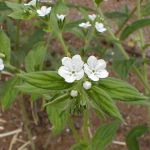| Common Name: |
Red-rooted Gromwell |
| Botanical Name: |
Lithospermum erythrorhizon syn. L. officinale subsp. erythrorhizon |
| Genus: |
Lithospermum |
| Family: |
Boraginaceae |
| Native Location: |
E China, Korea, Japan |
| Cultivation: |
Well-drained, neutral to alkaline soil in sun or partial shade. |
| Propagation: |
By seed sown in autumn; by division in autumn. |
| Harvest: |
Whole plants are cut when flowering, and roots are lifted in autumn; all parts are dried for use in decoctions. |
| Height: |
40-70cm (16-28in) |
| :Width |
30cm (12in) |
| Hardiness: |
Z8-9 |
| Parts Used: |
Whole plant, roots (zi cao) |
| Properties: |
A sweet, soothing, healing herb that lowers fever and clears toxins. It stimulates the liver, heart, and circulation, and has contraceptive and anti-cancer effects. |
| Medicinal Uses: |
Internally for irritant skin conditions, measles, chicken pox, boils, carbuncles, hepatitis, and skin cancer. Externally for eczema, diaper rash, burns, abscesses, poison oak or ivy rash, vaginal discharge, and herpes. |
| Economic Uses: |
Extracts are added to skin care creams. |
| Bibliography: |
Encylopedia of Herbs by Deni Brown Copyright ©: 1995, 2001 Dorling Kindersley Limited pg 265
|

